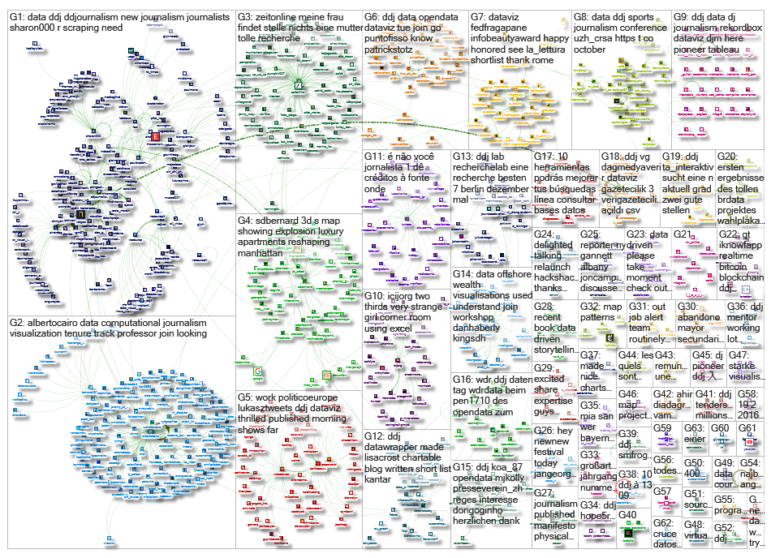What’s the global data journalism community tweeting about this week? Our NodeXL #ddj mapping from Oct 8 to 14 finds 25 inspirational data visualizations collated by @VismeApp, a @nytimes op-ed by climate scientists warning of the future dangers of heat and humidity combined, @FT maps of New York’s glut of luxury residences and @ejcnet with veteran data journalists on web scraping.
Inspirational Dataviz
Intricate and inspirational, this list of 25 best data visualizations of 2018 curated by Visme are true works of art. Pore over these amazing and diverse visualizations, including @STcom’s Marvel Cinematic Universe, James Round’s Many Moons of Jupiter, @SCMPgraphics’ Crazy Rich Asians, and more.
The 25 Best Data Visualizations of 2018 | Visual Learning Center by Visme https://t.co/aTuLTdaIfp pic.twitter.com/ZUY6DEKI7W
— Ninja Economics (@NinjaEconomics) October 6, 2018
Killer Combo: Heat and Humidity
Climate scientists discuss the dangers of the combination of heat and humidity, which could be so extreme that the evaporation of human sweat won’t sufficiently cool our bodies, leaving even healthy adults at risk of death from overheating. They further warned that about 11 million people are projected to be at risk of suffering heat and humidity past the limit of human tolerance at least once by 2080.
A visual op-ed about increasing heat: https://t.co/uLw7cAVouw
Great concepts! Outside contributors (here: climate scientists) pitch an idea. The article then is produced in close collaboration with @nytgraphics editors.#ddj #dataviz
— Patrick Stotz (@PatrickStotz) October 12, 2018
Manhattan’s Penthouse Pileup
Manhattan’s stock of unsold luxury homes is piling up but a new crop of ultra high-end high-rise residences are in the works. Could the city be faced with a glut of prime property? The Financial Times mapped the location and prices of future luxury residential high rise buildings in Manhattan.
Some impressive 3D mapping and animation from @sdbernard out today #dataviz #ddj #gistribe https://t.co/zAacxBuLph pic.twitter.com/46NJsjOTyI
— Martin Stabe (@martinstabe) October 10, 2018
Aging Bridges
The Baltimore Sun provides a snapshot of bridges in Baltimore and its surrounding areas. The bridges are color-coded by condition: good, fair and poor. It also discusses what the rating of bridges means and the challenges of rehabilitating them.
.@baltimoresun looked at which bridges in the region are listed in “poor” condition — and in particular, which have been “poor” for several years.
33 city-owned bridges in Baltimore were “poor." That’s 13 percent — nearly double the national average.https://t.co/5Hd8J3hoDV pic.twitter.com/GG3VUAMiLz
— kalani (@kalanigordon) October 8, 2018
Web Scraping Essentials
Web scraping has become an integral skill for data journalists. Conversations with Data has pulled together some useful tips from veterans Paul Bradshaw, Peter Aldhous, Mikołaj Mierzejewski, Maggie Lee, Gianna-Carina Grün and Erika Panuccio, to show you how it’s done.
Great advice on web scraping. https://t.co/KDjvloDlBq
— Todd Wallack (@TWallack) October 10, 2018
Economist Gets On Open Data Bandwagon
The Economist announced that it will start publishing data behind its stories on GitHub. It is kickstarting its open data commitment with the release of the data behind its Big Mac Index, an interactive currency comparison tool based on the prices of burgers in any two countries.
This is wonderful: @TheEconomist is going to start publishing more of their data analysis on Github #opendata #datajournalism https://t.co/HCUQxFReM1 – itching to get my grubby paws on the inner workings of the Big Mac Index
— Sam Beckbessinger (@beckbessinger) October 11, 2018
Meet the Investigator
ICIJ’s Meet the Investigators series profiles Helena Bengtsson, data chief at SVT, Sweden’s public broadcasting network. Bengtsson looks at big datasets as if she were interviewing a person. And she is old-fashioned when it comes to scraping: she uses PERL, a tool which has been abandoned by most, in favor of Python.
"I was that strange girl in the corner of the room using Excel, but nobody really understood what I was doing." @HelenaBengtsson talks about the early days of data journalism in this month's #MeetTheInvestigators. https://t.co/g6itMnDuqE #ddj pic.twitter.com/nFcfKX1ENu
— ICIJ (@ICIJorg) October 9, 2018
R for Journalists
See how much you can do in just a few lines of code with these excerpts from Sharon Machlis’s new book Practical R for Mass Communication and Journalism.
Sample chapters from my new #rstats book are now available free online: https://t.co/fwEupxL2Gf
* Introduction
* Get Started With R in a Few Easy Steps
* See How Much You Can Do in a Few Lines of Code
* Import Data into R
* Basic Data Exploration
* R on Election Day#ddj— Sharon Machlis (@sharon000) October 11, 2018
Sports Data Journalism Conference
The University of Zurich’s Center for Research in Sports Administration (CRSA) will host a sports, data and journalism conference on October 25, 2018. The conference provides a platform for experts from research, media and industry to discuss the use of data science in sports. Speakers will include behavioral scientist Chris Anderson, Tamedia’s data journalism lead Barnaby Skinner and CRSA board member Ulrich Woitek.
This is great news -> Journalists can apply for reduced fees (50% to completely free)! Conference on Sports, Data, and Journalism with over 35 speakers and 2 #ddj workshops! apply now https://t.co/LY2Oe2FDI9 https://t.co/lkqcwZRWJd
— Anıl Özdemir (@anil_oezdemir) October 10, 2018
Infographics MOOC (Spanish)
EducaciOnline (UOC) is offering a MOOC (massive open online course), “Introduction to Infographics and Data Visualization.” The course is divided into four modules over four weeks and is taught in Spanish.
Mañana empieza el #MOOC sobre iniciación a la infografía y visualización de datos de @UOCxtended
¡Todavía estás a tiempo de inscribirte! 👉https://t.co/xxjjXKJEjm pic.twitter.com/cbie9VNXEQ— UOC biblioteca (@UOCbiblioteca) October 8, 2018
Thanks, once again, to Marc Smith of Connected Action for gathering the links and graphing them.
 Eunice Au is GIJN’s program coordinator. Previously, she was a Malaysia correspondent for Singapore’s The Straits Times, and a journalist at the New Straits Times. She has also written for The Sun, Malaysian Today and Madam Chair.
Eunice Au is GIJN’s program coordinator. Previously, she was a Malaysia correspondent for Singapore’s The Straits Times, and a journalist at the New Straits Times. She has also written for The Sun, Malaysian Today and Madam Chair.

